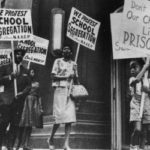Review the facts, rulings, majority and minority opinions, and reasoning of these two landmark Fourteenth Amendment Supreme Court cases – Batson v. Kentucky and J.E.B. v. Alabama.
The 19th Amendment and the Road to Universal Suffrage
In this activity, students will explore the struggle for universal suffrage long after both men and women constitutionally had the right to vote. Following a progressive timeline, primary sources highlight voting problems that arose for minority groups throughout the 20th century. Students will answer questions as they work through the documents to reflect on if and when universal suffrage was ultimately achieved.
The Power of One Decision: Brown v. Board of Education

When minority students decided to take their challenge of the “separate but equal” doctrine to the Supreme Court, the 1954 decision handed down by the court in Brown v. Board of Education and enforced by the executive branch, changed their lives and America forever. In this lesson plan, based on the Annenberg Classroom video “A Conversation on the Constitution: Brown v. Board of Education,” students gain insight into decision-making at the Supreme Court, learn about the people behind the case, construct a persuasive argument, and evaluate the significance of Brown v. Board of Education.
Gratz v. Bollinger & Grutter v. Bollinger (2003)
Does the University of Michigan’s policy on accepting minority students violate the Equal Protection Clause? This case summary shows how the Supreme Court answered that question in 2003.
The Origin, Nature and Importance of the Supreme Court
Chief Justice John G. Roberts Jr. and high school students discuss the Supreme Court: its history and traditions, how it selects and decides cases, and the role of an independent judiciary. A lesson guide accompanies the video.
Grade 6-8 The Bill of Rights & Me
The purpose of this lesson is to investigate the Bill of Rights through the perspective of someone living during the ratification period. After exploring the historical perspective of the Bill of Rights through study of the Dissent of the Minority in Pennsylvania, students will be asked to apply the rights they learned about to their lives today and assess, critique, and solve problems based on the modern meaning of these rights.
The Nature of Dissent in the Supreme Court
Ratifying the Constitution

This lesson introduces students to the vigorous debates between the Federalist and the Anti-Federalists surrounding the ratification of the Constitution that took place in the state conventions.
In the state ratification conventions, delegates argued the wisdom of adopting the Constitution. Elected specifically to serve in these conventions, they came from a range of backgrounds, from the very elite and highly educated, to those of humbler birth and station. State delegates grappled with questions about the nature of democracy, the distribution of wealth and power in society, the rights of individuals and minority groups, and the role of dissent in a republic.
